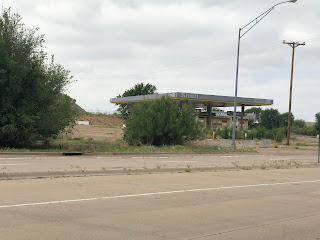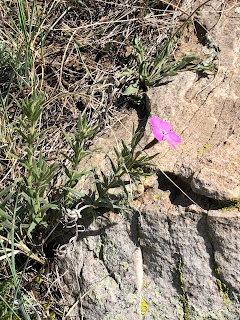Breakfast at "Kix on 66" was excellent.
Tucumcari has the Blue Swallow Hotel, Tepee Curios and Motel Safari, all newly restored.
Where businesses have gone bust, as you have seen all along the route, there is no attempt to pull them down if they are of no historic or artistic merit and tidy the place up. Everything is just left to decay. And sometimes on a large scale. This was a former service plaza on 66.
And as for the abandoned cars -
Beyond Santa Rosa, there is a choice of following I40 direct to Albuquerque or do the Santa Fe loop, which takes longer but is more picturesque. I chose the latter, and headed north on Highway 84. Much of the vegetation had been mesquite and juniper, but the mesquite dies out as you go north and climb.
84 is fairly quiet, although there is regular traffic including trucks. Soon after joining it, I screeched to a halt. They were being rightly optimistic back in Vega, although I was further west.
There were either two small herds of the pronghorn, one on each side of the highway, or a single herd that had become separated. In spite of the absence of traffic, they moved swiftly away when I stopped and put down the windows. This was the best I could do.
I detoured a little from 66 to visit the Las Vegas (not that one) National Wildlife Reserve. It was not the best time of year to visit as the ponds which attract wildfowl in winter were already drying up and there were only a few shoveller on the pond that could be seen from the road. There were some possible Ibis in the very far distance, but you really needed a telescope. However, I did make the acquaintance of this little lady, who belonged to the NWR ranger.
Looking north and east, the mountains are the south-west edge of the Rockies, still snow-capped.
This area is on the western edge of the Great Plains which run from Illinois to New Mexico. They are known as short-grass plains as the mix of grasses differs from those in the more eastern states. Very little unspoilt plains grasslands still exist. Those that do protected areas. This is a semblance of how they would have looked. Close up, you can see a wide range of species of grass. This ecosystem developed over millennia, and was essentially created by the grazing of buffalo and elk. The NWR now has controlled grazing to try and restore the balance.
I took a short walk (!) into a canyon created by the course of a dried-up stream.
 |
| Long-leaved phlox phlox longiflora |
Leaving the NWR, I headed back slightly north and west to Santa Fe, where I spent the night.



















No comments:
Post a Comment